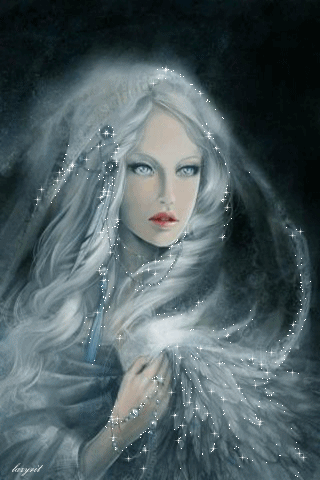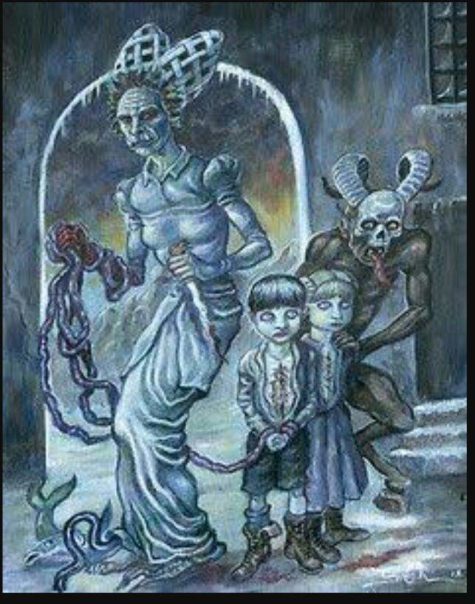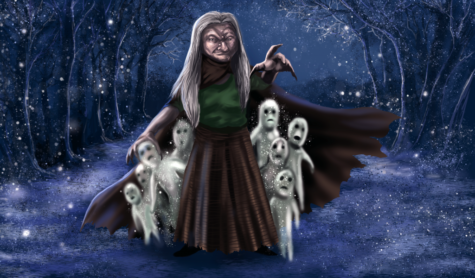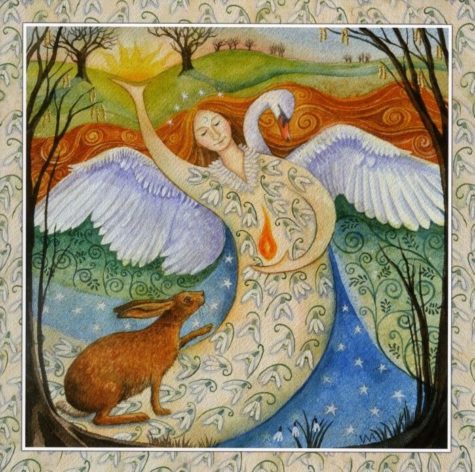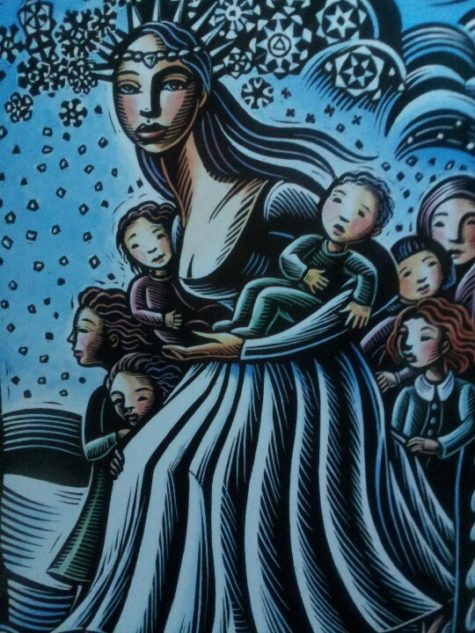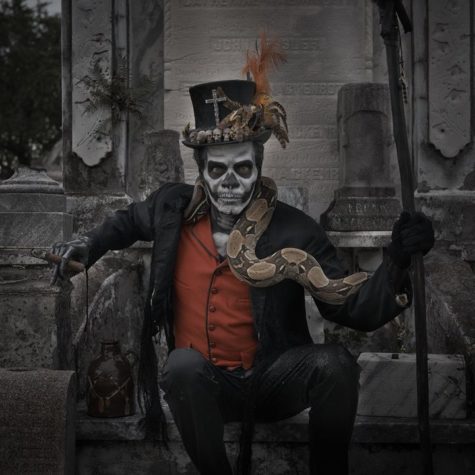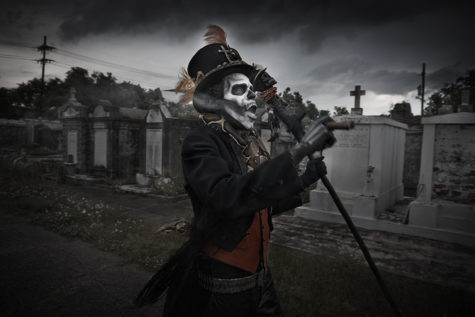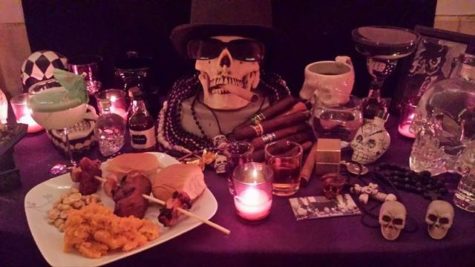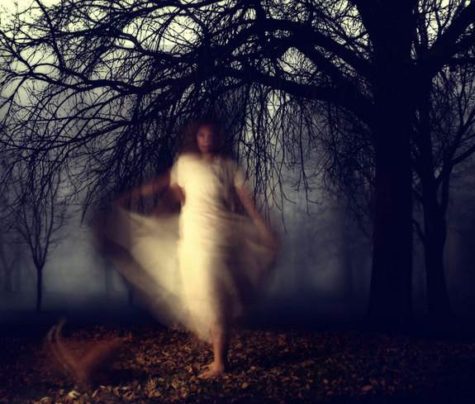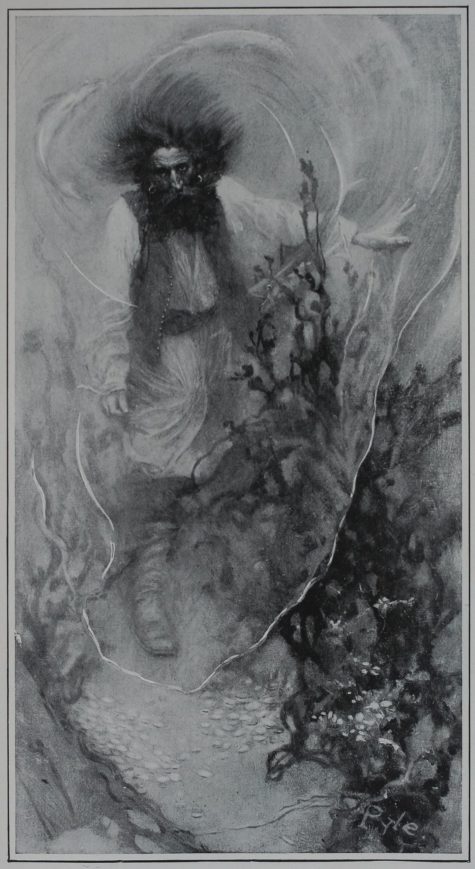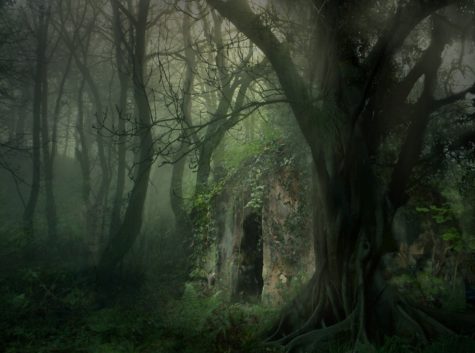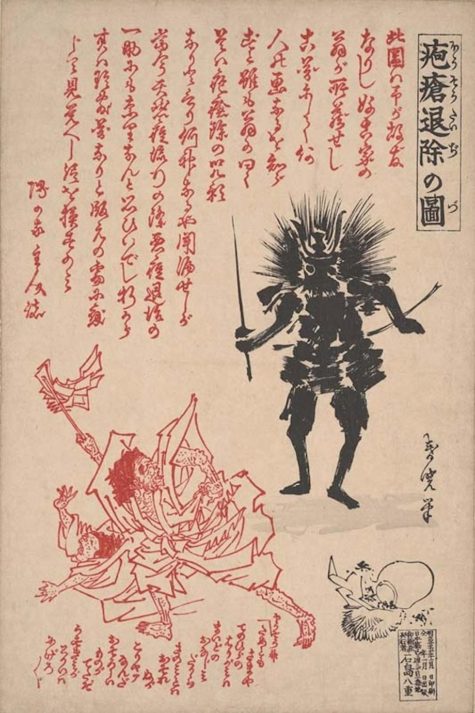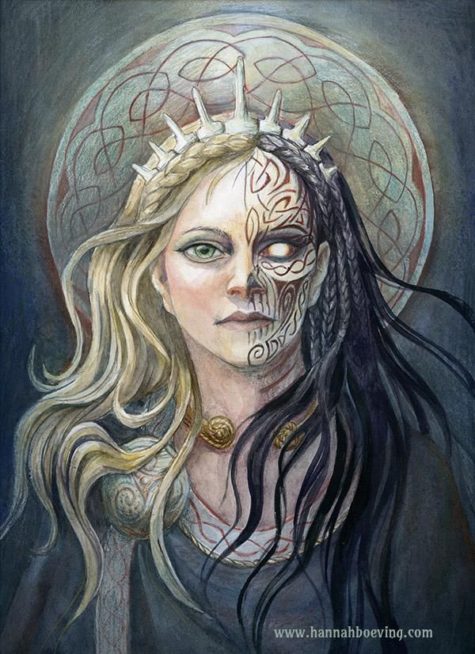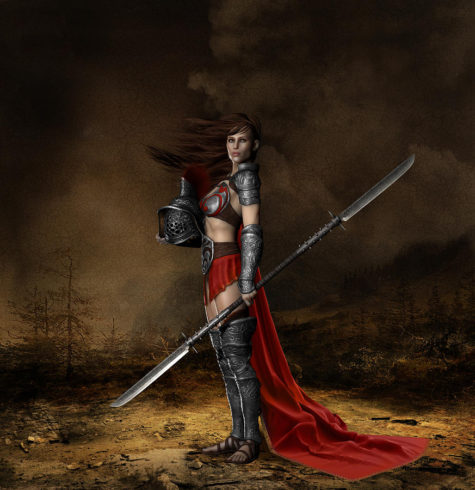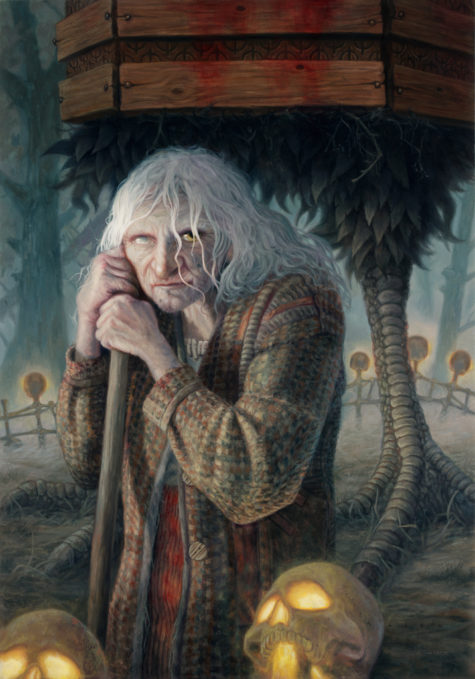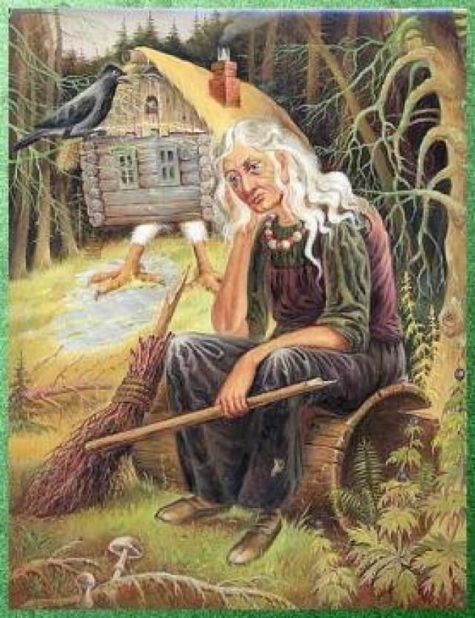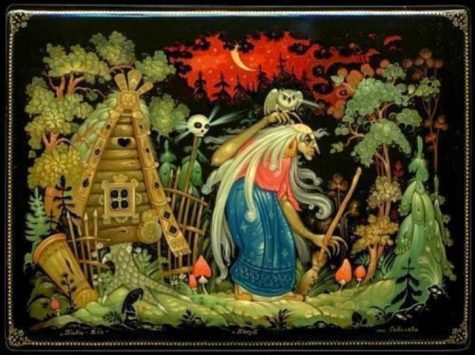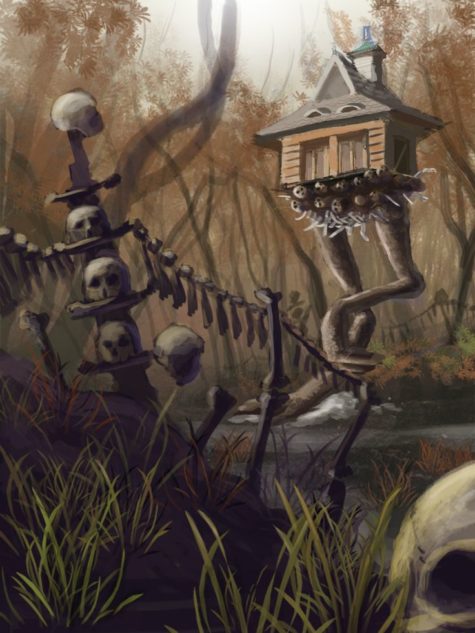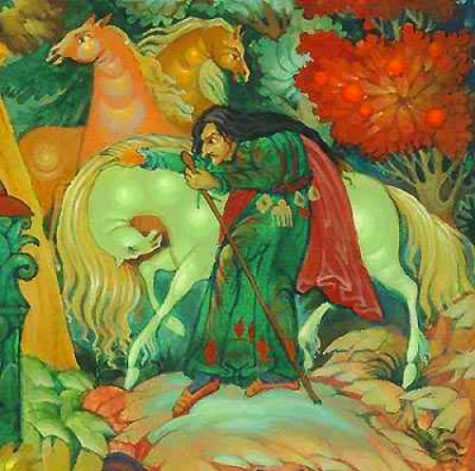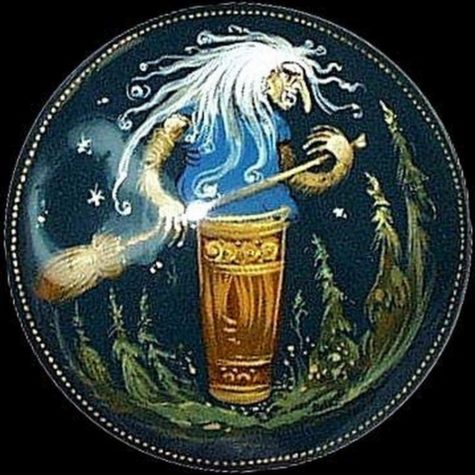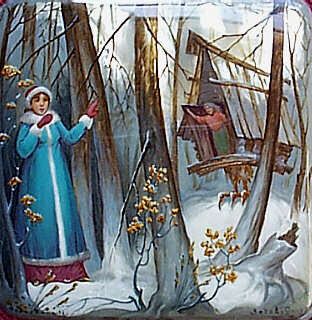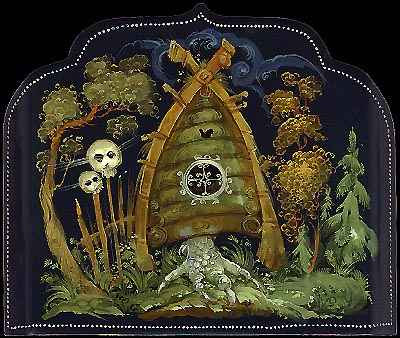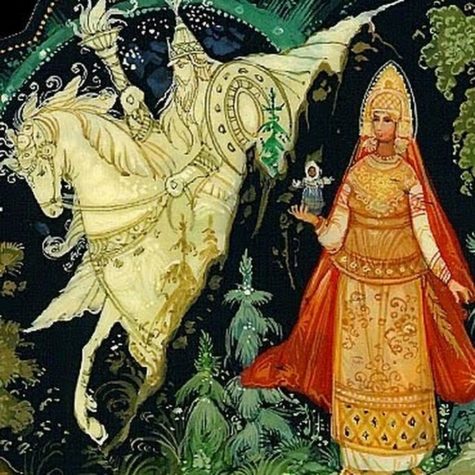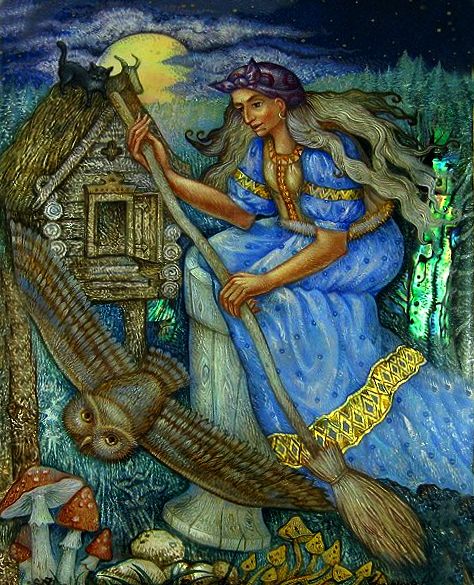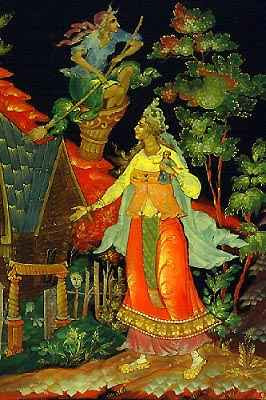Death
- Titles: Goddess of Abundance, Queen of Witches
- Also known as: Bertha; Perchta; Frau Berta; Eisen Berta, Berchtli
- Origin: Germanic
- Sacred plants: Holly, mayflower
- Sacred creatures: Crickets, swans, geese.
Bavaria is the ancient stronghold of Berchta, goddess of abundance. Allegedly whatever you give her will be returned many times over. Berchta rules a sort of transit area for souls, caring for and guarding those who died as babies. Depending on the version, they either stay in her garden forever or she tends them until they reincarnate and receive new life. She protects living children, too. German folk tales describe a beautiful lady dressed in white who mysteriously appears in the middle of the night to nurse babies.
Initially, Perchta was the upholder of cultural taboos, such as the prohibition against spinning on holidays. She was an immensely popular goddess, and so post-Christianity she was aggressively demonized by the Church as a Queen of Witches. People were told to baptize their babies because otherwise they’d end up in Berchta’s realm, not in Heaven. She is among the leaders of the Wild Hunt, usually leading a parade of unbaptized babies.
She evolved into a bogeywoman still invoked as a threat to make children behave before Yule. She allegedly punishes “bad children” but gives gifts to good ones.
This old story is as follows:
In the folklore of Bavaria and Austria, Perchta was said to roam the countryside at midwinter, and to enter homes during the twelve days between Christmas and Epiphany (especially on the Twelfth Night). She would know whether the children and young servants of the household had behaved well and worked hard all year. If they had, they might find a small silver coin next day, in a shoe or pail. If they had not, she would slit their bellies open, remove stomach and guts, and stuff the hole with straw and pebbles.
She was particularly concerned to see that girls had spun the whole of their allotted portion of flax or wool during the year. She would also slit people’s bellies open and stuff them with straw if they ate something on the night of her feast day other than the traditional meal of fish and gruel.
Berchta protects:
- Unbaptized babies
- Stillbirths, miscarriages, abortions
- Those driven to suicide by broken hearts or despair
- Dead souls who lack people to remember them
- Dead souls who have not received proper, respectful burial
The types of dead souls Berchta protects have a tendency to trouble the living by manifesting as destructive ghosts. Should you be afflicted by such a ghost, petition Berchta to soothe and remove it, escorting it to her realm, where it will be much happier.
- Manifestations
A beautiful woman with pearls braided into her gold hair. A white veil obscures her face, and she wears a long, white silk dress. She has another look too: an old decrepit hag with long, wild grey hair and disheveled clothes.
In many old descriptions, Bertha had one large foot, sometimes called a goose foot or swan foot. Grimm thought the strange foot symbolized her being a higher being who could shapeshift to animal form. He noticed that Bertha with a strange foot exists in many languages:
“It is apparently a swan maiden’s foot, which as a mark of her higher nature she cannot lay aside…and at the same time the spinning-woman’s splayfoot that worked the treadle”.
Because she sometimes manifests with one webbed goose foot, it is possible that Berchta may be the original Mother Goose. In the Tyrol she appears as little old woman with a very wrinkled face, bright lively eyes, and a long hooked nose; her hair is disheveled, her garments tattered and torn.
- Attributes
When she’s young and beautiful, she carries the keys to happiness in one hand and a spray of mayflowers in the other; as a hag, she carries a distaff.
- Realm
A subterranean palace with a fabulous garden where she welcomes souls of children who died in infancy.
She maintains other homes within hollow mountains.
- Spirit allies
Perchta travels with a retinue of spirits called Perchten. Christian legend says the devil rides in their midst, but this may indicate the presence of a male deity who accompanies her.
- Sacred time
Berchta is celebrated throughout the entire Yule season. Post-Christianity, Yule became synonymous with Christmas, but in its original Pagan context it was a lengthier season.
In German tradition, the Feast of the Epiphany (Jan 6) is Berchtentag – Berchta’s Day. The preceding eve is Berchtennacht. The festival is celebrated with processions characterized by grotesque masks.
- Sacred places
Berchtesgaden in the Austrian Alps means “Berchta’s Garden.” Many springs near Salzburg are named in her honor.
- Offerings
Leave offerings out for her on Epiphany Eve, the way offerings are left for Santa. Not milk and cookies, though. Berchta likes a hearty meal: herring and dumplings is her favorite. Give her schnapps or other alcoholic beverages.
A Goddess of Many Names
Perchta had many different names depending on the era and region: Grimm listed the names Perahta and Berchte as the main names, followed by Berchta in Old High German, as well as Behrta and Frau Perchta. In Baden, Swabia, Switzerland and Slovenian regions, she was often called Frau Faste (the lady of the Ember days) or Pehta or ‘Kvaternica’, in Slovene. Elsewhere she was known as Posterli, Quatemberca and Fronfastenweiber.
In southern Austria, in Carinthia among the Slovenes, a male form of Perchta was known as Quantembermann, in German, or Kvaternik, in Slovene (the man of the four Ember days). Grimm thought that her male counterpart or equivalent is Berchtold.
Regional variations of the name include Berigl, Berchtlmuada, Perhta-Baba, Zlobna Pehta, Bechtrababa, Sampa, Stampa, Lutzl, Zamperin, Pudelfrau, Zampermuatta and Rauweib.
Modern celebrations
In contemporary culture, Perchta is portrayed as a “rewarder of the generous, and the punisher of the bad, particularly lying children”.
Vestiges of devotion to Berchta survive in some Alpine villages where it is traditional to place offerings of food for her on rooftops so she finds them while riding by.
Today in Austria, particularly Salzburg, where she is said to wander through Hohensalzburg Castle at dead of night, the Perchten are still a traditional part of holidays and festivals (such as the Carnival Fastnacht). The wooden animal masks made for the festivals are today called Perchten.
In the Pongau region of Austria large processions of Schönperchten (“beautiful Perchten”) and Schiachperchten (“ugly Perchten”) are held every winter. Beautiful masks are said to encouraging financial windfalls, and the ugly masks are worn to drive away evil spirits.
Other regional variations include the Tresterer in the Austrian Pinzgau region, the stilt dancers in the town of Unken, the Schnabelpercht in the Unterinntal region and the Glöcklerlaufen (“bell-running”) in the Salzkammergut. A number of large ski-resorts have turned the tradition into a tourist attraction drawing large crowds every winter.
From: Encyclopedia of Spirits and Wikipedia
- Titles: Master of the Cemetery, Lord of the Dead
- Also known as: Bawon, Samedi, Bawon Sanmdi, Baron Saturday, Baron Sandi
- Colors: Black, also red and purple
- Day: Saturday
- Numbers: 3, 7, 21
- Classification: Lwa
- Consort: Madame Brigitte (Maman Brigitte)
- Venerated in: Haitian Vodou, Louisiana Voodoo, Folk Catholicism
- Feast: November 2
- Patronage: Death, tombs, gravestones, cemeteries, dead relatives, obscenities, healing, smoking, drinking, disruption, spirits
Baron Samedi is one of the loa of Haitian Vodou. He is the leader of the Barons and possibly the Gedes. He presides over a sprawling, confusing, complex clan of spirits. When people speak of the Baron, they tend to mean Baron Samedi. Baron Samedi literally means Baron Saturday, which may sound innocuous compared to Baron Cemetery, or Krininel, but Saturday was the one day when Christ was really truly dead, the day between the crucifixion on Friday and resurrection on Sunday. On Saturday, even Jesus must answer to the Baron, Lord of the Dead.
Baron Samedi is Grand Master of the Celestial Masonic Lodge of Vodou Spirits, a thirty-second degree initiated Mason. He is invoked to contact and communicate with the dead. He determines whether they can come visit or not. He may be petitioned to remove bothersome ghosts and invoked to ward off death.
He is noted for disruption, obscenity, debauchery, and having a particular fondness for tobacco and rum. Additionally, he is the loa of resurrection, and in the latter capacity he is often called upon for healing by those near or approaching death, as it is the only Baron who can accept an individual into the realm of the dead.
Baron Samedi spends most of his time in the invisible realm of vodou spirits. He is notorious for his outrageous behavior, swearing continuously and making filthy jokes to the other spirits. He is married to another powerful spirit known as Maman Brigitte, but often chases after mortal women. He loves smoking and drinking and is rarely seen without a cigar in his mouth or a glass of rum in his bony fingers.
Baron Samedi can usually be found at the crossroads between the worlds of the living and the dead. When someone dies, he digs their grave and greets their soul after they have been buried, leading them to the underworld.
He is a powerful healer and is especially sympathetic to terminally ill children. Baron Samedi rules the cemetery: no one can die until he gives permission for their grave to be dug. Baron Samedi is lewd, obscene, and vulgar, but he can be just and kind. He prefers that children live full lives before joining him in the cemetery.
Baron Samedi is the crossroads where sex and death meet. Spirit of the undying life-force, he may be petitioned for fertility. He is the guardian of ancestral knowledge and the link to your ancestral spirits. If one lens keeps popping out of your dark glasses, the Baron may be seeking your attention or offering his patronage.
Baron Samedi is syncretized to Jesus Christ as they share the symbol of the cross. It is possible that Baron Samedi’s associations with the cross may pre-date christianity. In Congolese cosmology, the cross is the symbol of the life cycle: death – birth – rebirth. He may also be syncretized to Saint Expedite, and with Saint Martin de Porres.
- Note:
Syncretized means to attempt to unite and harmonize especially without critical examination or logical unity.
Manifestations:
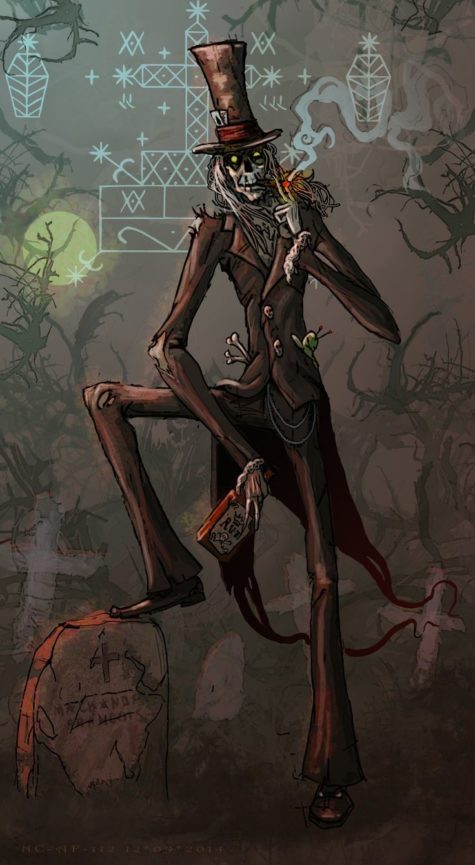 Baron Samedi manifests as an older, dark-skinned man in formal attire, dressed completely in black. He wears a black top hat, black suit, and may be smoking one of his beloved cigars. He wears impenetrable black sunglasses.
Baron Samedi manifests as an older, dark-skinned man in formal attire, dressed completely in black. He wears a black top hat, black suit, and may be smoking one of his beloved cigars. He wears impenetrable black sunglasses.
- The glasses may be missing a lens because he possesses two kinds of vision: he simultaneously sees the realms of the living and the dead.
- Alternatively his glasses have but one lens because a penis has but one eye and the phallus is his attribute (and because he loves sexual humor and innuendo.)
He is usually depicted with a top hat, black tail coat, dark glasses, and cotton plugs in the nostrils, as if to resemble a corpse dressed and prepared for burial in the Haitian style. He has a white, frequently skull-like face (or actually has a skull for a face), and speaks in a nasally voice. The former President for Life of Haiti, François Duvalier, modeled his cult of personality on Baron Samedi; he was often seen speaking in a deep nasal tone and wearing dark glasses.
- Favored People
Children; women seeking to conceive; funeral workers; grave diggers; those whose work brings them into contact with death.
Connection to other loas:
Baron Samedi is the leader of the Guédé, loa with particular links to magic, ancestor worship and death. Samedi is a loa of the dead, along with Baron’s numerous other incarnations Baron Cimetière, Baron La Croix, and Baron Kriminel. These lesser spirits, all dressed like the Baron, are all as rude and crude, but not nearly as charming as their master. They help carry the dead to the underworld.
Working with Baron Samedi
- Iconography: Baron Samedi’s throne is a chair chained to a cross. Images of Darth Vader are supposed to represent him (or just to decorate his altar; he likes toys)
- Attributes: Coffin; phallus, skull and crossbones; shovel; grave; black sunglasses; cross
As well as being master of the dead, Baron Samedi is also a giver of life. He can cure any mortal of any disease or wound, if he thinks it is worthwhile. His powers are especially great when it comes to vodou curses and black magic. Even if somebody has been afflicted by a hex that brings them to the verge of death, they will not die if the Baron refuses to dig their grave. So long as this mighty spirit keeps them out of the ground, they are safe.
He also ensures that all corpses rot in the ground to stop any soul from being brought back as a brainless zombie. What he demands in return depends on his mood. Sometimes he is content with his followers wearing black, white or purple clothes or using sacred objects; he may simply ask for a small gift of cigars, rum, black coffee, grilled peanuts, or bread. But sometimes the Baron requires a vodou ceremony to help him cross over into this world.
- Offerings
Black coffee, plain bread, dry toast, roasted peanuts. He drinks rum in which twenty-one very hot peppers have been steeped. Cigars, cigarettes, dark sun glasses, Day of the Dead toys, the sexier and more macabre the better; raise a skull and crossbones pirate flag for him, beautiful wrought-iron crosses are crafted in his honor.
- Veve
The veve or symbol for Baron Samedi is as follows:
Sources: Wikipedia and Encyclopedia of Spirits
The simplest definition of ghosts is that they are souls of the dead. Theoretically the word ghost encompasses all dead souls. However, dead souls who fade away and never reappear are memories, not ghosts. The word ghost implies that the dead soul maintains a presence in the realm of the living or perhaps refuses to leave.
Some ghosts may not realize they’re dead or may not know how to leave or where to go. In these cases, the living can intervene to help them transition via rituals, through shamans, or by requesting that a psychopomp escort the dead soul to safety.
Whether the presence of a ghost is intrinsically harmful is subject to debate. In some cultures, contact with ghosts is toxic to the living either because of mal-intent or just because contact with the dead is debilitating. Other cultures consider each ghost an individual case. Some are benevolent; some are lethal; others are just neutral presences having little effect one way or the other.
Some ghosts exhibit scary behavior, but many people find all ghosts frightening just because of their associations with death or the supernatural. No chain-clanking or nocturnal groaning is required; the ghost doesn’t actually have to do anything to cause fear other than be present.
Not all ghosts mean harm. Some simply enjoy lingering near the living. They do feed off human energy, tapping into the energy of individuals as if it were a power source: There’s a bit of a vampiric quality to this, but if not excessive it will not harm the average healthy individual. A ghost may actually be less energy-draining than some living “psychic vampires.”
Ghosts who linger without causing trouble can be tolerated. Some people enjoy the presence of ghosts. The reputed presence of ghosts is a selling point for many hotels, inns, and bed-and-breakfasts. Sensitive people can see ghosts, even if the ghosts don’t want to be seen. Put out an offering for them periodically. Make them feel welcome and this type of ghost can transform into an ally or be helpful in emergencies.
Some ghosts remain on the earthly plane because they are caught in a time warp: they constantly relive a tragedy that they experienced while alive. Some ghosts won’t leave because they have a mission. It may be to protect someone, to reveal information, or to seek revenge. Some ghosts are consumed with rage and resentment.
Raging ghosts who loathe and envy the living are dangerous ghosts. The most powerful can manifest in corporeal form and harm the living. Ghosts who are powerful enough to exert their individuality often transcend ghost status to become spirits. If honored and propitiated, even hostile ghosts can sometimes be persuaded to use their power benevolently.
Spirit mediums channel dead souls for benevolent purposes. Seances invite participation of dead souls so that they can provide information, comfort, and healing. Some dead souls, however, possess the living for their own selfish or destructive purposes. These must be exorcised or somehow made to leave.
Various spirits are renowned ghost busters. Sometimes even an image or amulet bearing their name is sufficient to send ghost packing. See the Ghost Busters page.
If a ghost can’t be exorcised, it can be distracted. Many ghosts, like low-level demons, demonstrate obsessive-compulsive behavior. Scatter tiny poppy or millet seeds. The ghost may feel compelled to pick up or count each and every one.
- Hanging up a many-holed sieve or fish net may have the same effect.
- Alternatively leave a ghost some thread and a needle with a broken eye. Some ghosts will spend eternity attempting to thread the needle, in the process, ceasing their depredations.
How someone died may effect what type of ghost they become. Allegedly those who die suddenly, violently, or before their time are more likely to become malevolent ghosts. In many parts of the world, the most feared ghost is a woman who died in childbirth. It’s crucial to point out, however, that not everyone who dies violently becomes a harmful ghost. Clearly most murder victims do not transform into rampaging supernatural beings, or there would be far less murder. It is not entirely clear why some victims of violent crimes turn into benevolent helpers while others become utterly consumed with rage and anger toward the entire world.
Various botanicals are said to discourage the presence of ghosts, especially rue and garlic. See the post on Ghost Busting with Botanicals for a more extensive list.
From: Encyclopedia of Spirits
A revenant is an animated corpse typically possessed by a spirit that was believed to return from the grave to terrorize the living. The word “revenant” is derived from the Latin word, revenans, “returning” (see also the related French verb “revenir”, meaning “to come back”).
Vivid stories of revenants arose in Western Europe (especially Great Britain, and were later carried by Anglo-Norman invaders to Ireland) during the High Middle Ages. Though later legend and folklore depicts revenants as returning for a specific purpose (e.g., revenge against the deceased’s killer), in most Medieval accounts they return to harass their surviving families and neighbors. Revenants share a number of characteristics with folkloric vampires.
Many stories were documented by English historians in the Middle Ages. William of Newburgh wrote in the 1190s,
“It would not be easy to believe that the corpses of the dead should sally (I know not by what agency) from their graves, and should wander about to the terror or destruction of the living, and again return to the tomb, which of its own accord spontaneously opened to receive them, did not frequent examples, occurring in our own times, suffice to establish this fact, to the truth of which there is abundant testimony.”
Stories of revenants were very personal, always about a specific individual who had recently died (unlike the anonymous zombie depicted in modern popular culture), and had a number of common features.
Source: Wikipedia
The dark powers emanate from the dark aspects of the Goddess and the God. This is the power of the Crone and the Lord of the Shadows; the Hag and the Hunter. The dark powers are more than just a personification of the negative influences in life, however, and the energy raised through the dark imagery of the Divine is very potent. As such, be careful what you do.
The Dark Goddess is manifested in mythology as various kinds of death crones, wise hags, devastation, war, disease and barrenness of the land. She is the Bone Mother who collects the skulls of the dead for the ossuary. In Irish mythology, Morrigan and Nemain would be considered Dark Goddesses in that they are associated with War and Death.
The Dark God is seen in mythology as the silent host to the dead in his underground realm of gray shadows and deep sleep, knowing of secrets and wise of the universe, death, war, destruction, gatherer of souls and harbinger of chaos. He is the Hunter, whose wild hunt, or raid, ingathers the energies of the soul.
There is sense to this ancient cosmology. Cults of ancient times focused on the dark aspects of the Divine so that their followers would move past their fear of mortality to seize upon the recognition of their eternal immortality.
In Irish mythology, Crom Cruach, and Donn would be considered “Dark Gods” or “Dark Powers” because Donn was the god of the dead Milsians. At death, Mannannan Mac Lyr carried the soul to Tech Dunn or the House of Donn. In texts like the Dinsenchus there is references to Crom being considered to be a dark god, contrasting a light god, in a way that is very similar to the Slavic god Czernobog.
As a power, the Dark Lord is the Chaos from which Order must evolve. Yet there is no ending to this cycle, Order resolves again as Chaos to be reborn as New Order. The Lord of Shadows as Death becomes the process of new life by gathering the energy of dying life, and the Passage into a new material form is through the Crone.
In the aspect of light, the god dies willingly by entering the ground to bring his vitality to crops that will be harvested to feed humanity. Through this selfless act, he revitalises the earth. He does this through the Crone. The marriage of Lugh in August, celebrated as Lughnasadh, is the start of the descent into Mother Earth. Once there, he is transformed into the son within the goddess. Hence, the pagan god is both Father and Son, which is yet another concept that Christianity absorbed from the pagans. The harvest comes, the seasons change, and the Mother becomes the Crone of Autumn and Winter, only to be transformed into Mother again at Winter Solstice with the rebirth of the Sun (her son, the god). See Also: Cernunnos, Green Man and Herne.
The womb-tomb is the domain of the Crone and is a place of great power. This is where the transformation takes place, with energies of death given repose and returned to form as the energies of life. When this power is confronted and recognised, there comes a freedom from fear, a new sense of independence and a recognition of personal responsibility. We are not judged in Death by the Lady and the Lord, but we are Self-judged. From the quietude of the realm, we move through her into new life. That is the balanced, pagan theme of the cauldron, the god of self-sacrifice and the resurrecting goddess. It is this power of the goddess that significantly differentiates the old and new religions.
Thus, in an historical sense, while the Dark Lord guides the chaos of social and cultural changes through the Crone into a new life, the Crone becomes not the terror of death, but the joyful passage to new vibrant societies through the death of the outmoded and stagnant ones. She is Fata Morgana, the Huntress Diana, Minerva, Cerridwen, Sati and Kali. He is Pluto, Hades, Cerunnos, Herne the Hunter, Set and Shiva. But the names may not convey the image needed by the practitioner unless you are able to move beyond the modern association of darkness as evil.
By accepting that the dark powers are in balance with the light powers, you are able to utilise the wholeness of the Power. The dichotomy of good and evil do not apply to what simply is. Energy can be drawn to the light or to the dark; thus death provides the soul’s passage to whichever realm the soul-energy has been drawn. Energy is always in motion, and flows back and forth between light and dark. What at one time is light energy turns and becomes dark energy. Through the practice of the Craft, the witch directs this energy for beneficial purpose. To do otherwise, is to inflict Self-harm.
To face the Underworld and the power of the dark aspect of the Divine is to understand that dark is part of the necessary blend of light and not something to fear. The unifying of the dark and the light within the individual offers wholeness and peace, which may then be transferred to external contacts.
From: Green Witchcraft II
- Origin: Japan
- Classification: Kami
- Color: Red
- Offerings: Rice with red adzuki beans
Hosogami are smallpox spirits. (Hoso is the Japanese word for smallpox.) For safe recovery to health, the Hosogami must be soothed, propitiated, and sent on their way. Hosogami are pleased to see the color red. Physicians were glad to see the color red too:
- Purple smallpox rashes indicate the illness is in a dangerous stage.
- If and when rashes turn red, the patient is expected to recover.
The person suffering from small pox and those caring for him dressed in red to appease the Hosogami. In addition, “red prints” or hoso-e prints, paper wall amulets were posted at the first hint of small pox to propitiate, avoid, and/or banish the illness.
Daruma and Shoki possess the power to expel Hosogami and are among the spirits portrayed on red smallpox talismans.They are called “red” because that’s the primary color of these prints. If no print is available, red banners may suffice.
Following the patient’s recovery, these prints were traditionally ritually burned or floated down rivers to signal the departure of the spirit. Extremely few survive and these are now extremely valuable collectors items.
Source: Encyclopedia of Spirits
- Also known as: Hella, Hela
- Origin: Norse
- Colors: Black and white
- Rune: Hagalaz
- Mount: Hel rides a black mare
- Animals: She has a pack of dogs, the original Hell Hounds, as well as horses and wolves
- Spirit allies: Hel’s staff includes servants named “Delay” (male) and “Slowness” (female)
Manifestations:
Hel is simultaneously half-dead and half-alive. Half of her body (cut vertically) is that of a fair, beautiful woman; the other half is necrotized flesh. She is half living woman, half corpse.
Attributes:
Rake and broom; the Black Plague was especially devastating in Scandinavia. Allegedly Hel roamed the land armed with her rake and broom. Villages totally wiped out by the Plague were said to have been swept away; where there were survivors, Hel had raked instead.
The Mythology:
Once upon a time, being sent to Hel may have been inevitable, but it wasn’t perceived as punishment: Hel, daughter of Angerboda and Loki, rules the Norse realm of the dead. She is the keeper of the souls of the departed. Those who die at sea or in battle have other destinations; everyone else goes to Hel, who welcomes them into her home, Helhaim, regardless of whether they were good, bad, sinful, or saintly while alive.
Hel’s realm is not a sulphurous, fiery torture chamber. Rather it is a kind of inn or way station for the dead, although once checked in, one can never check out. Helhaim is a bleak gray, damp, misty realm; the concept of heat as punishment was imported from hotter, southern climes alongside Christianity. Lack of warmth with no hope of Spring was the Norse equivalent of desolation. That said, some regions of Helhaim are more comfortable than others; Hel judges and decides exactly where each individual soul is directed.
Hel’s name may derive from the Old German halja, meaning “covering.” She may or may not be the same spirit as Hulda (Holle). Hel and her brothers, a wolf and a snake, were raised by their mother, the witch Angerboda, in the Iron Wood. Prophecy suggested that the siblings would someday lead a Host of Destruction against the Aesir, and so Odin had them “brought” to Asgard, where each was ultimately entrapped. Odin personally seized Hel and flung her as far as he could; she landed in the Realm of Death and became its Queen. She lives in a great hall, Eliundnir, within Helhaim. She remains destined to lead an uprising of rebellious spirits and ghosts.
Hel manifests in dreams, most famously to Balder, Odin’s son. She appeared to him three days before his death, advising him (accurately) that in three days she would clasp him in her arms. Because her father was instrumental in killing Balder, it’s unclear how much inside information Hel possessed.
Places:
Mount Hekla, an active volcano in southern Iceland, was allegedly among the entrances to Hel’s realm. A nearby town is named Hella. Some have suggested that the mountain shares its name with the goddess, although others protest that Hekla means “slab” or covering,” which would still make it cognate with Hel as that is what her name means, too. It’s also theorized that the Belgian city of Hal may be named in her honor.
Feast Days:
The Anglo-Saxon and Norse Goddess of the Underworld is honored annually on the Day of Hel (July 10th) with prayers, the lighting of black candles, and offerings of rose petals.
Found in: Encyclopedia of Spirits
- Also known as: Bella Donna; Duellona
- Origin: Rome; possibly Etruscan
- Feast Day: June 3
Bellona, Goddess of War and Conquest, was once extremely popular with Roman soldiers. Roman senate meetings pertaining to foreign wars were conducted in Bellona’s temple on the Capitoline Hill.
Bellona’s name derives from the same root as bellicose and belligerent. Some consider it safer to call her Bella Donna. Bella Donna, literally “Beautiful Lady,” contains the name Bellona within it. It may be a euphemistic pun so that one could refer to Bellona without actually calling upon this beautiful but fierce lady.
Classical Roman mythology classifies Bellona, Lady of War, as belonging to the family of Mars. She is variously described as the wife or sister of Mars, less often his daughter, and sometimes his charioteer or nurse.
- Favored people: Soldiers, those who battle.
- Manifestation: A beautiful woman with long windswept hair, girded for battle.
- Attributes: Scourge; whip (to whip troops into frenzy); torch (to light her opponents’ funeral pyres).
- Sacred plant: Belladonna, (atropa belladonna), a beautiful but lethal killer, shares her essence.
- Sacred Sites: In addition to her Roman temple, Bellona had a temple outside York, England, and a shrine in Arfeuilles, France, now home of the Black Madonna of the Hollies. She was venerated wherever Roman soldiers traveled.
This goddess did not play a significant role in either myth or legend, and her worship appears to have been promoted in Rome chiefly by the family of the Claudii, whose Sabine origin, together with their use of the name of Nero, has suggested an identification of Bellona with the Sabine war goddess Nerio.
Her temple at Rome, dedicated by Appius Claudius Caecus (296 B.C.) in fulfillment of a a vow during the Third Samnite War with the Samnites and Etruscans, stood in the Campus Martius, near the Flaminian Circus and Porta Carmentalis (the Carmenta gate), and outside the gates of the city. It was there that the senate met to discuss a general’s claim to a triumph, and to receive ambassadors from foreign states. In front of it was the columna bellica, where the fetialis ceremony of declaring war was performed, in which a spear was cast against the distant enemy.
Note:
This native Italian goddess should not be mistaken for the Asiatic Bellona, whose worship was introduced into Rome apparently by Sulla, to whom she had appeared, urging him to march to Rome and bathe in the blood of his enemies. Her feast day was changed to the 24th of March, after the confusion of the Roman Bellona with her Asiatic namesake. See Day of Blood
In Slavic folklore, Baba Yaga is a supernatural being (or one of a trio of sisters of the same name) who appears as a deformed and/or ferocious-looking woman. Baba Yaga flies around in a mortar, wields a pestle, and dwells deep in the forest in a hut usually described as standing on chicken legs (or sometimes a single chicken leg).
Baba Yaga may help or hinder those that encounter or seek her out. She offers comprehension, not comfort. She sometimes plays a maternal role, and also has associations with forest wildlife. She is a many-faceted figure, capable of inspiring those who seek to see her as a Cloud, Moon, Death, Winter, Snake, Bird, Pelican or Earth Goddess.
Baba Yaga is an enigmatic spirit who rules the conjunction of magic and harsh reality, of limits and possibilities. This Death Spirit provides fertility when she chooses, but she also consumes those who disappoint her. She is iron-toothed, boney-legged, and wears a necklace of human skulls. Her home is surrounded by a fence crafted from human bones and, when inside of her dwelling, she may be found stretched out over the stove, reaching from one corner of the hut to another.
Like her compatriot spirits, Kali and La Santisima Muerte, Baba Yaga encompasses all the mysteries of life and death; contemplate her in order to begin to comprehend these mysteries. I don’t suggest contacting her (the Baba has little patience; don’t waste her time without good reason), a kind of magical contemplation is recommended instead.
Connecting With Baba Yaga
The Baba Yaga’s Feast Day is usually celebrated on the first full moon in November, but a connection can be made at any time during the year.
- Build an altar featuring birch wood and leaves, animal imagery, a mortar, pestle and broom, and especially, food and drink.
- Baba Yaga is always voraciously hungry. Offer her real food or cut out photo images for the altar. She is especially fond of Russian extravagances like coulibiac.
- Offer her a samovar with blocks of fine Russian caravan tea and perhaps a water pipe.
- Sit with the altar, gaze at it from different angles, play with the objects and see what comes to mind.
Be patient, and expect that it will take time to achieve a connection and a response.
More About Baba Yaga
The ‘old woman’ of autumn was called Baba by the Slavic inhabitants of eastern Europe, Boba by the Lithuanians. This seasonal divinity lived in the last sheaf of grain harvested in a year, and the woman who bound it would bear a child that year. Baba passed into Russian folk legend as the awesome Baba Yaga, a witchlike woman who rowed through the air in a mortar, using a pestle for Her oar, sweeping the traces of Her flight from the air with a broom.
A prototype of the fairytale witch, Baba Yaga lived deep in the forest and scared passersby to death just by appearing to them. She then devoured Her victims, which is why Her picket fence was topped with skulls. Behind this fierce legend looms the figure of the ancient birth-and-death Goddess, one whose autumn death in the cornfield led to a new birth in spring.
Baba Yaga is a Slavic version of Kali, the Hindu Goddess of Death, the Dancer on Gravestones. Although, more often than not, we consider Baba Yaga as a symbol of death, She is a representation of the Crone in the Triple Goddess symbolism. She is the Death that leads to Rebirth. It is curious that some Slavic fairy tales show Baba Yaga living in Her hut with Her two other sisters, also Baba Yagas. In this sense, Baba Yaga becomes full Triple Goddess, representing Virgin, Mother, and the Crone.
Baba Yaga is also sometimes described as a guardian of the Water of Life and Death. When one is killed by sword or by fire, when sprinkled with the Water of Death, all wounds heal, and after that, when the corpse is sprinkled with the Water of Life, it is reborn. The symbolism of oven in the Baba Yaga fairy tales is very powerful since from primordial times the oven has been a representation of womb and of baked bread. The womb, of course, is a symbol of life and birth, and the baked bread is a very powerful the image of earth, a place where one’s body is buried to be reborn again.
It is interesting that Baba Yaga invites Her guests to clean up and eat before eating them, as though preparing them for their final journey, for entering the death, which will result in a new clean rebirth. Baba Yaga also gives Her prey a choice when She asks them to sit on Her spatula to be placed inside the oven: if one is strong or witty, he or she escapes the fires of the oven, for weak or dim-witted ones, the road to death becomes clear.”
Baba Yaga lives in the middle of a very deep forest, in a place which is often difficult to find unless a magic clue (a ball of yarn or thread) or a magic feather shows the way. The old hag lives in a wooden hut on two chicken legs (sometimes three or four legs are described).
Usually the hut is turned with its back towards a traveler, and only magical words can make it turn around on its chicken legs to face the newcomer. Very often, the hut revolves with loud noises and painful screams that make a visitor cringe. This serves to frighten the reader, showing the hut’s old age, and to show that Baba Yaga does not care about her hut’s well being.
- Baba Yaga fairy tales can be found at Widdershins.
It is also fascinating that some fairy tales describe the hut as being a unique evil entity: firstly, it has the ability to move on its chicken legs. Secondly, it understands human language and is able to decide whether and when to let a visitor enter its premises. Finally, the hut is often depicted as being able ‘to see’ with its eyes (its windows) and ‘to speak’ with its mouth (its doorway). I also cannot help feeling that the hut is able ‘to think’, and one can observe these thoughts as wild powerful clouds of steam emerging from the hut’s chimney. What powerful imagery!
Baba Yaga’s hut is often surrounded by fence made of human bones and topped with human skulls with eyes. Instead of wooden poles onto which the gates are hung, human legs are used; instead of bolts, human hands are put in; instead of the keyhole, a mouth with sharp teeth is mounted. Very often Baba Yaga has her hut is protected by hungry dogs or is being watched over by evil geese-swans or is being guarded by a black cat. The gates of Baba Yaga’s villa are also often found to be guardians of Yaga’s hut as they either lock out or lock in the Witch’s prey.
Baba Yaga – The Black Goddess – An Essay
For those of you who enjoy a more scholarly approach to the goddess, here is an essay by an anonymous author about Baba Yaga, the Black Goddess, and what her mythology represents.
Baba Yaga and her Magical Colts
I have been thinking and thinking about the image and story of Baba Yaga now for months and wondering how girls and women can resolve the seemingly paradoxical story of a bony heartless witch with the image of innocence of a rejected and abandoned girl. The following essay outlines how we use myth and story to perpetuate unconscious mindsets and it also unveils the gifts that these stories unfold in our inner psyche.
The story of Baba Yaga is prime among many images of the Black Goddess. The Black Goddess is at the heart of all creative processes and cannot be so easily viewed. Men and women rarely approach her, except in fear. Women are learning of her through the strength and boldness of elder women who are not afraid to unveil her many faces.
Sofia as wisdom lies waiting to be discovered within the Black Goddess who is her mirror image. Knowing that, until we make that important recognition, we are going to have to face the hidden and rejected images of ourselves again and again.
As women, we are confronted throughout our lives with unavoidable body messages regarding the uniqueness of our form and the inevitable changes that characterize aging and the passage of time. Although aging presents difficult challenges for both men and women, women confront some specific difficulties because of their gender. In traditional narratives, the end of biological fertility has relegated women to the status of “old women” who are stereotypically viewed as poor, powerless, and pitiful in our sexist and youth oriented culture. Baba Yaga, often referred to as the Black Goddess, and Vasalisa, often representing Sophia, are intrinsic to the psyche of girls and women because they shows us that the illusion of form can hide wonderful qualities within.
Baba Yaga, ugly, haglike, flying in her mortar,
seemingly isolated and abandoned,
yet broom at hand, ready to sweep the clouds across the skies
and reveal her hidden cosmic nature
One of the cruelest of stereotypes that older women face is the “menopausal woman.” These are accentuated by the very fact that younger women are often rejecting or distancing to older women in society, unwilling to identify with women older than themselves. These experiences are painful confirmations that the aging woman no longer meets the social criteria of a physically and securely attractive woman. The common result for most women is the activation of shame — as if becoming/looking older means that something is deeply and truly wrong with oneself.
Conscious femininity is a cyclic process and involves an awakened awareness of the triple form of the Goddess – Mother, Virgin and Crone – and how she exists simultaneously and continuously in all of our psyches, each taking center stage in awareness at different moments. These archetypal patterns are considered intrapsychic modes of consciousness in the individual, and the primordial image of a powerful and integrated woman, crowned with wisdom gleaned through real experience, is again reemerging through both the individual and collective psyches of humanity.
First, however, women must learn to embrace, respect and honor their changing bodies, abilities, capacities and WISDOM. We can learn a lot from Baba Yaga!
An archetype is a universal symbol, an inherited mental image to which humankind responds, and which is often acted upon as an unconscious reaction to human experience. These stories are no different and the story of Baba Yaga exemplify this phenomena.
The female experience is symbolized by and archetypally corresponds with the ancient Triple Goddess as the creator and destroyer of all life — “the ancient and venerable female divinity embodying the whole of female experience as Virgin, Mother, Crone.” The archetypal figure representing the end of a woman’s childbearing years, or the “third age” for women, is the third aspect of the Triple Goddess, the Crone.
At the climacteric or menopause, women are often forced to stand precipitously between the culmination of past experiences, to realize that youth is left behind, and prepare a new space within whereby a fresh image will coalesce as she envisions her future. This is real labor. The traditional constructs that are available to women are largely influenced by patriarchal standards of youth and beauty and we need fresh constructs that honor the diversity of life in all of its forms.
When a culture’s language has no word to connote “wise elder woman,” what happens to the women who carry the “Grandmother” consciousness for the collective? Prejudicial (prejudged) attacks throughout history against older women symbolized patriarchy’s feminization of fear: the ultimate fear of annihilation, to be nonexistent (no existence). Centuries-long indoctrination limits our imagination so that we see this ancient aspect of the feminine only in her negative forms. We see her as the one who brings death to our old way of being, to our lives as we have known them, and to our embodied selves.
Our fear of the unconscious makes the Crone or Baba into an image of evil. The prevalence of paranoid masochism finds its expression through feminine perversion. Kristeva writes from “Stabat Matar” that: “Feminine perversion is coiled up in the desire for law as desire for reproduction and continuity, it promotes feminine masochism to the rank of structure stabilizer.” Structure stabilizer! Natural death is to be feared, hidden away, certainly not recognized as part of the natural rhythm of cycles of birth, death and rebirth?
Only when death becomes projected does it become a monster to be feared. There is an unconscious belief that a woman who has outlived her husband has somehow used up his life force. Walker claims that the secret hidden in the depths of men’s minds is that images of women are often identified with death. Women have also bought into this mindset largely because of lost connection with their own spirituality and the natural cycles of nature!
Vasalisa Approaching the Hut of Baba Yaga
To be sent to Baba Yaga was tantamount to being sent to one’s death, but Vasalisa was actually helped by Baba Yaga. By facing her own worst fear — death itself, Vasalisa became liberated from her previous situation and immaturity.
The myths of our society tell us much about the attitudes and world view of the myth-owners, and these attitudes are the products of women’s roles within the wider society. Myth arises out of the collective level of humankind’s experience, which is presented through images and symbols that resonate within our psyche. It is something we inherit from our ancestors and it is expressed through our genetic, racial memory. Kaufert reminds us however, that “myth is a system of values presented as if it were a system of facts.”
The symbol of the Crone is unique to a feminine worldview where the face of the Virgin and the fecund Mother, the Virgin Mother Mary, was absorbed in Western tradition into Judeo-Christian imagery. Likewise, we see the image of Vasalisa embodied as this innocence. The Crone has retained much of her pre-patriarchial character where she has haunted the fringes of Western culture, largely ignored, unacknowledged and rejected; one that often strikes fear into the hearts of men and some women because she has tremendous power and cannot be confined.
“Wise women,” in the past, were literally seen as having the power of life and death. They symbolized maturity, authority, attuned to nature and instinct. They were women whom men could not bind by making pregnant. They personified, as Hall writes:
“That aspect of life that men would most like to control but against which they are powerless: death. The Crone was healer, seer, medicine woman and, when death arrived with inexorable certainty, she was the mid-wife for the transition to another life.”
Baba Yaga’s Hut standing on its magical Chicken-Leg,
yet revolving like the solar symbol it is,
always rising and setting in a new place,
bringing birth — and death — daily.
Over time, and in recent history the Crone became associated with the dark side of the feminine; the withered old hag, the witch. Ironically, the word “Hag” used to mean “holy one” from the Greek hadia, as in hagiolatry, “worship of saints.” And during the middle ages hag was said to mean the same as fairy.
In deconstructing these familiar images of the older aging woman, we must first identify their symbolic roots and challenge them in order to allow for potent, vital images that energize women’s potential creative spiritual evolution. In this quest it is crucial to find valued female images that present creative and spiritual power, that offer a paradigm of ongoing formation and integration. If we do not do so, we risk encountering images of women that reinforce stereotypical models and moreover, can only alienate us from our own truest selves.
The Crone is a figure who incorporates both dark and light, life and death, creation and destruction, form and dissolution. The doll [Vasalisa’s doll, given to her by her dying mother] becomes the symbol of the Sibyl, a figure of inspiration and intuition. She acts as a guide through the great passages of life, leading a woman into her own inner knowing.
Vasalisa and her doll with the White Horseman of Dawn(who reports daily to Baba Yaga, just like the Red Horseman of Noon, and the Black Horseman of Evening)
We see this in the story of Vasalisa and Baba Yaga, the innocence of the maiden coming of age through a series of tasks. Baba Yaga forces Vasalisa to look within through intuition (the doll) and she awakens to the illuminating light that is carried in her heart. Within the simple limits of a folk story, the interactions of Sophia (Vasalisa) and the Black Goddess (Baba Yaga) are demonstrated. Baba Yaga or the Crone also embodies the inner archetype of Sophia, feminine wisdom.
Hall writes: “Sophia is a Wise Woman, one who epitomizes feminine thought. This thought is of a particular kind. It is ‘gestalt’ or whole perception; it synthesizes and looks at the overall pattern; it is logical but empathetic, and combines acute observation with intuition. It is relational (taking account of the past in order to project forward into the future), and it arises out of care and concern for man and womankind. It uses both the left and right brain modes of thought. It is creative and concerned with vision and solutions — attributes which are an integral part of the Wise Woman.”
Sophia plays, hides, adepts, disguises, and brings justice. Interestingly, we see these very same qualities attributed to the wise woman as being Vasalisa’s, only not fully formed. Thus affirming the feminist perspective of the Goddess in all of her aspects and that all ways to wisdom are valid paths. Girls and women are encouraged to rely on their own subjective experience or on the communal experience of other women This is a very important point!
From a feminist perspective, the entry into the third phase of women’s life is seen as a time of spiritual questing, renewal and self-development. It is a time where women are encouraged to explore themselves through interaction with other females who are providers of friendship, support, love, even sexual satisfaction, rather than a woman’s family.
Baba Yaga helping young Ivanushka
Likewise, the young girl growing into maidenhood needs the guidance and wisdom that elder women can provide. She must receive the gifts that the wise ones can give her. Baba Yaga may appear as a witch, yet she is instrumental in folk traditions. She aids heroes to find weapons, simplifying tasks and quests when she is treated with courtesy. Her transposed reflection is none other than Vasilisa the fair – the young righteous maiden who defeats her opposite aspect by truth and integrity.
The older woman is the keeper of the wisdom and tradition in her family, clan, tribe, and community. She is the keeper of relations, whether they be interpersonal or with all of nature. Every issue is an issue of relationship. It is assumed that she has a deep understanding of the two great mysteries, birth and death.
Another quality is the ability to be mediator between the world of spirit and earth. She is emancipated from traditional female roles of mothering and is free to make a commitment to the greater community. As a result of this freedom, there is an abundance of creativity unleashed in this phase of life; often expressed through art, poetry, song, dance, and crafts, and through her sexuality as she celebrates her joy (Joussance).
This elder time must again become a stage of life revered and honored by others and used powerfully in service by women themselves. The elder “Wise-woman” can represent precisely the kind of power women so desperately need today, and do not have: the power to force the hand of the ruling elite to do what is right, for the benefit of future generations and of the earth itself.
A powerful Baba Yaga, flying in her mortar,
protecting her forests, and banishing all obstacles with her pestle and broom.
Like Baba Yaga, the Crone must help us by her example and “admonish us to revere all peoples and all circles of life upon this earth . . . not only important for the dignity and self-esteem of each woman, but vital for the countenance of life on our sweet Mother Earth.” Since men define power as the capacity to destroy, the Destroying Mother Crone must be the most powerful female image for them, therefore, the only one likely to force them (us) in any new direction.
A woman who denies her life process at any time in her development, clinging desperately to outmoded images, myths and rituals of her past, obscures her connection with Self, the Divine, and therefore, with her spiritual heritage, the natural universe. The same holds true for our daughters, maidens who are coming of age. There is a kind of internal balance and sense of holiness available to us when we accept ourselves as part of a world that honors cycles, changes, decay and rebirth. It is time for women to reflect and give form to the authentic self in its evolving, formative process.
The woman who is willing to make that change must become pregnant with herself, at last. She must bear herself, her third self, her old age with labor. There are not many who will help her with that birth. To Crone is to birth oneself as “Wise-woman,” and see the world through new eyes.
We have not had the safety valve of feminine metaphor in our spiritual understanding; consequently, the Feminine, both Divine and human, have appeared monstrously contorted, threatening and uncontrollable.
The Black Goddess lies at the basis of Spiritual knowing, which is why her image continuously appears within many traditions as the Veiled Goddess, the Black Virgin, the Outcast Daughter, the Wailing Widow, the Dark Woman of Knowledge.
The way of Sophia is the way of personal experience. It takes us into the realm of “magical reality,” those areas of our lives where extraordinary vocational and creative skills are called upon to manifest. Those treasures of Baba Yaga and Vasalisa lie deep within each of us, waiting to be discovered.
Baba Yaga and Vasalisa,
Crone and Puella [Maiden]: Two Aspects of One Archetype
Sources:
